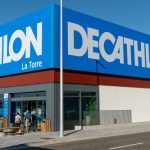Vans brand revenue fell 13 percent (-9 percent in constant dollars) to $927 million in the fiscal third quarter ended December 31, reflecting positive performances in Europe and Asia outside of Greater China, while the Americas remained problematic. During a conference call with analysts, VF Corp. Interim CEO Benno Dorer called out the brand as a major focus for improvement as it continues to be a drag on the overall VFC business.
“We have two near-term key priorities, which represent significant value creation opportunities,” Dorer explained on the call. “First, turning around our Vans performance through improved consumer execution; and second, returning to supply chain excellence across the company.”
Dorer, the former CEO and chairman of The Clorox Company until he retired from a full-time corporate career two years ago, said the company has good in-house examples of how to turn around the Vans Americas business by looking no further than The North Face business and Vans’ execution in the EMEA region where Vans revenue was up 7 percent in the fiscal quarter.
“On Vans, we clearly have been challenged for some time now,” Dorer expressed. “This is predominantly a challenge in the Americas, and it is mostly executional in nature. For perspective, Vans Q3 revenue rose by 7 percent in EMEA, but declined by 13 percent in the Americas, which is primarily North America and accounted for 90 percent of the global Vans Q3 revenue decline.”
While there are differences in the EMEA compared to the North American market, Dorer said the relatively stronger performance of Vans in EMEA reflects the benefits of a clear growth strategy and stronger marketplace execution. “We must do better with Vans in its home market, and we will,” he said.
Dorer laid out an action plan that follows the four growth drivers set out at the company’s Investor Day last September—consumer, products, marketplace, and operating model.
“Here are a few specific examples of actions,” Dorer detailed. “We will sharpen our view of the changing consumer landscape through a new consumer segmentation, which is underway and will inform the business’ overall growth strategy and begin to influence our direct-to-consumer plans as of summer this year. We need to delight consumers in ways that are relevant to their specific needs. And to do so, we must be more intimately familiar with them.”
Dorer said the company would also better turn data and insights into significant consumer opportunities for Vans. He highlighted what he described as a strong untapped opportunity with the brand’s UltraRange product line. “Here, awareness is very low at around 10 percent among all consumers and at below 30 percent even among Vans’ loyalists,” he explained. “So we’ve started to boost awareness, and this is starting to yield results. UltraRange revenue grew 34 percent in Q3 with much more growth to be had.”
The VF chief said the MTE and Half Cab product lines have similar potential for Vans. He committed that in the future, the company would drive these and other promising platforms longer and more continuously. “We will significantly increase our investment in product innovation, funded by a reduction in costs in lower value areas with actions, including SG&A reduction and improving store profitability,” he said.
According to Dorer, Vans’ product development investment, as a percentage of revenue, lags well behind the company average. “We will change that starting with fiscal year 2024,” he said. “This will help us aggressively pursue new styles and make our innovation pipeline more consistently strong. We will also eliminate unnecessary SKU complexity to simplify and, importantly, amplify the shopping experience.”
Dorer pointed to a small test at the brand’s Irvine, CA store that led to a footwear revenue improvement of plus 12 percentage points with 30 percent fewer SKUs. “We will begin to expand this initiative as of fall fiscal year 2024,” he commented. “We will move our digital spending principle from budget cap based to flexible and ROI-based to take advantage of available spending opportunities that translate into incremental revenue and profits. It is early, but we have already seen an improvement in profitable DTC growth rates only a few weeks into this change.”
Dorer also said the company would sharpen its processes regarding the Vans business. “In fiscal year 2024, we will go to market at retail, including wholesale customers with clearly aligned and integrated product calendars,” he explained. “This will lead to better plans that are more centered around the consumer. And to drive Vans forward, we have made tremendous progress putting a world-class Vans leadership team in place. Two critical leaders, our new chief product and merchandising officer; and our new chief digital officer, have both joined in December, and they’re off to a fast start.”
In particular, in digital. The North Face is the business with the strongest digital growth among the VF brands, and that’s another area that Dorer believes Vans can learn from, and they are reapplying some of the North Face learning on Vans.
“Beyond that, what I would say also reflecting that perhaps knowing that hindsight is always 20/20,” Dorer admitted. “When we saw the particularly strong growth in Vans, one opportunity we perhaps missed was to invest into it.” And what we’re doing on the North Face now and what you can expect on the North Face in fiscal year 2024, is an increase in our investment towards the consumer. And the money will go towards digital performance marketing, the money will go towards brand building and the money will go towards innovation.
“Vans continues to be a fundamentally strong brand,” Dorer said. “The number of consumers buying Vans during the last 12 months was up, as was brand advocacy. But many people buy the brand less often. So what we do need to do is to fuel the brand more consistently and give people more reasons to buy more Vans. That is on us, and that’s what we will do.”
In response to an analyst question regarding the changes the company is implementing, Dorer shared that what gives him confidence is that it’s clear that improving the performance is not some obscure concept, but it’s entirely within the company’s control. “We know how to do this, Dorer said. “And the way to bring Vans back is by consistently executing against consumers with excellence. What that means is great product, great marketing, great shopping experiences and, of course, the customer service issues that we talked about. And then when we think about the specific plan in which we indeed have quite a bit of confidence. There are a number of actions that impact the business now.”
Dorer reiterated that the company is moving to ROI-based digital spending and that is sees strong results behind that.
“We’re boosting awareness of existing product platforms like UltraRange, and we’re seeing good results behind that,” he shared. “We have new products expanding now like a low land and our new school shoes and also UltraRange VR3, those are going out now, and we think that those are attractive new products. And finally, I have seen the new challenge that we’ve brought in to complement our leadership team in action, and I have high confidence in them. And if you add to that some of the more fundamental changes that we’re making, which will begin to impact the business in the second half of next fiscal year, like the new consumer segmentation, like a digital-first operating model and a new go-to-market upgrades, which again, we’ve already applied in EMEA, in Europe, and that’s working well. The SKU reduction for which we have a store test with really strong results. And then they had on top, the increased spending that we’re planning to put in place behind product innovation. Those are all very tangible things. Those are things that have worked for Vans in the past. Those are working elsewhere in the portfolio, and those are all on us.
“And that’s the good news here. The good news/bad news, I should say,” he concluded. “The bad news is that we’re in this situation but the good news is that addressing the performance opportunity that we have on Vans is entirely within our control, and we’re pursuing a plan that is very specific very credible with a high sense of urgency. That’s where my confidence comes from.’
Looking ahead, Vans revenue is expected to post a high-single-digit decline in constant dollars for the fiscal year, compared to the previous outlook for a mid-single-digit decline. The North Face is expected to be up by at least 14 percent in constant dollars, compared to the previous outlook of up at least 12 percent.
Photo courtesy Vans
















